I have long been an avid reader of detective novels, psychological thrillers, crime fiction and cosy bibliomysteries. In anticipation of National Crime Reading Month in June, this week’s blog post in the ‘Celebrating Female Authors’ series celebrates female authors from the Golden-Age of crime fiction and Detection Club Crime Writers.
The 1920s and 30s mark the era of Golden-Age fiction, which saw the prolific publication of classic murder mysteries and detective novels, most of a similar style and genre. Agatha Christie, Arthur Conan Doyle, Dorothy L. Sayers are only a few of the many well-known detective writers of the time.
It was during the 1930s that the Detection Club was founded. This club consisted of a group of detective and crime writers including Dorothy L. Sayers, Anthony Berkeley, Freeman Wills Crofts, G. K. Chesterton, A.A. Milne and Agatha Christie. To join the club, new members had to follow a very particular initiation ceremony [1] which required solemnly promising to adhere to the Knox’s Commandments in their writing [2]. Some of the themes members of the Detection Club were forbidden to include in their novels were: ‘divine revelation, mumbo jumbo, jiggery-pokery, feminine intuition, coincidence or acts of God’ [3].
Mavis Doriel Hay
Biography
Very little is known about Mavis Doriel Hay. She was born February 1894, in Potter Bar, Middlesex [1]. While much of her work revolved around handicrafts, which she published under her married name, Mavis Fitzrandolph, Mavis Doriel Hay is also known for her three highly-praised detective novels which were published during the Golden Age of British detective fiction [2]. She died at the great age of 85 years on the 26th of August 1979 in Gloucestershire [1].
Literary Career



Mavis Doriel Hay wrote Murder Underground (1935-34) (which received high praise from Dorothy L. Sayers in an article in the 5798th issue of the Sunday Times, May 27th 1934), The Santa Klaus Murder (1936) and Death on the Cherwell (1935) [1], with the latter possibly being the most well-known of her three detective fiction works. Her detective novels have been reprinted in the British Library Crime Classics series [2].
However, her stint at writing detective novels was brief. Mavis Doriel Hay devoted her later career to the publication of books relating to crafts in Britain. These included: (1) Rural Industries of England and Wales (1929) (2) 30 Crafts (1950) (3) Traditional Quilting: Its Story and Practice (1954) (5) Quilting (1972) [2].
Links to Oxford

Mavis Doriel Hay was one of the first women to study at the University of Oxford – having matriculated at St Hilda’s College in 1913 [4] and studied there until 1916 [2]. Unlike her fellow male students at Oxford, however, she would not have received a degree from the University. Indeed, the University of Oxford only formally recognised female students in 1910 (only three years before Mavis Doriel Hay matriculated), and women were only first eligible for degrees in 1920, four years after Mavis Doriel Hay had left the university [3]!

Hay used St Hilda’s College as inspiration for the setting of ‘Persephone College’ in her book, Death on the Cherwell – not unlike Sayers’ Gaudy Night which was published later in the same year and similarly set in an imaginary Oxford college of a different name: Shrewsbury College [5]. In Hay’s book, students from Persephone College meet near the River Cherwell and discover the body of the unpopular college Bursar. Along with members from a neighbouring all-male college, these undergraduates attempt to investigate the suspicious death of the Bursar and find the culprit for this murder [6].
Death on the Cherwell tackles the important topic of women and their relationship with higher education in the early 1900s [5]. Like other female writers who use Oxford as a setting for their murder mysteries, such as Dorothy L Sayer’s as well as Gladys Mitchell, Mavis Doriel Hay no doubt used her experience attending a women’s college in the 1910s to inform her literary work and examine attitudes towards women who went to university [5].
References:
- http://carolwestron.blogspot.com/2015/08/mavis-doriel-hay.html
- https://en.wikipedia.org/wiki/Mavis_Doriel_Hay
- https://www.st-hildas.ox.ac.uk/content/pictorial-timeline
- https://view.officeapps.live.com/op/view.aspx?src=https%3A%2F%2Fwww.firstwomenatoxford.ox.ac.uk%2Ffiles%2Fstudents1878to1920-allcollegesfinalxlsx&wdOrigin=BROWSELINK
- https://www.tandfonline.com/doi/full/10.1080/09574042.2020.1723334
- https://happinessisabook.com/fridays-forgotten-book-death-on-the-cherwell-by-mavis-doriel-hay/
Gladys Mitchell

Biography
Gladys Mitchell, or ‘Great Gladys’ as she was called by her friend and novelist Philip Larkin, was an English writer best known for her detective fiction, featuring characters such as Mrs Bradley, Laura Menzies and Timothy Herring. She was born in Cowley in Oxford on the 21st of April 1901 [1] to Annie Simmons and James Mitchell — her father having worked from age 13 as a scout at Oriel College [5].
Gladys Mitchell studied at Goldsmiths College where she received an Education Teacher’s Certificate in 1921. She then went on to study at University College London whereupon she received a diploma in English and European History in 1925 [11]. Following her education, Gladys Mitchell taught History, English and on occasions coached hurdling, while also writing numerous books alongside this [1].
She was an early member of the Detection Club, as well as the British Olympic Association [2] and the Crime Writer’s Association [1].
She died on the 27th of July 1983 in Corge Mullen, Dorset [1].
Literary Career
Gladys Mitchell was highly regarded as a detective writer throughout the 1930s. Her debut novel, Speedy Death, was the first crime novel of 66 featuring Beatrice Adela Lestrange Bradley [1], a consultant psychologist for the Home Office [4].
Gladys Mitchell subsequently wrote many more books under the pseudonyms of Malcolm Torrie (for her historical novels) and Stephen Hockaby (for detective stories featuring an architect named Timothy Herring) [1]. She also wrote children’s novels, and many of her novels have been made into radio adaptations and television series by the BBC [1].
Her books explored themes of witchcraft, the supernatural, occult, archaeology, myth and folklore and incorporated Freudian psychology, topics that were of interest to Mitchell and which she had been encouraged to continue researching by her close friend and fellow novelist Helen Simpson [1, 4, 11].

Links to Oxford
Gladys Mitchell was born in Cowley in Oxford, and her father worked as a scout at Oriel College when he was only 13 years old [5]. Before that, he had received his education from the Cowley Fathers, an old male religious order of the Anglican Church in Oxford [6, 10].
The Weston Library holds Gladys Mitchell’s manuscript draft of one of her novels: The Greenstone Griffins [7]. It also has a correspondence between Gladys Mitchell and her friend and fellow author, Philip Larkin, in which she congratulates him on his text: The Oxford Book of Twentieth Century English Verse [8].
References:
- Gladys Mitchell – Wikipedia
- Gladys Mitchell: A biography
- Forgotten authors No 10: Gladys Mitchell | The Independent | The Independent
- Mitchell, Gladys (Maude Winifred) – Oxford Reference
- Gladys Mitchell: The Last of the Golden Age Writers
- https://www.encyclopedia.com/religion/encyclopedias-almanacs-transcripts-and-maps/cowley-fathers
- Collection: Manuscript draft of The Greenstone Griffins by Gladys Mitchell | Bodleian Archives & Manuscripts (ox.ac.uk)
- Correspondence between Gladys Mitchell and Philip Larkin congratulating him on the final version of the Oxford Book of Twentieth Century English Verse – File. Oxford Book of Twentieth Century English Verse – Subject files – Second Deposit – Papers of Philip Arthur Larkin – Archives Hub (jisc.ac.uk)
- http://gadetection.pbworks.com/w/page/7930445/Detection%20Club%2C%20The
- https://archive.org/details/the-armchair-detective-v-18-n-04-1985-fall/page/352/mode/2up
Dorothy L. Sayers
Biography

Dorothy L. Sayers was a celebrated poet and world-renowned crime writer [2], best known for her series of detective novels featuring Lord Peter Wimsey [3]. She was born on the 13th of June 1893 to Reverend Henry Sayers and Helen Leigh [1] at Christ Church Cathedral School in Oxford, where her father was Cathedral Chaplain [3].
Following her education in Cambridgeshire, Dorothy L. Sayers won a scholarship to study at Somerville College in Oxford. She was one of the first women to study and graduate from the University of Oxford with a First in Modern Languages in 1915 [3]. Her qualification was not formally awarded, however, as it would take another 5 years for women to receive degrees [3].
Before turning to writing full-time, Sayers worked in publishing at Blackwell’s before then moving to London and coming up with the slogan ‘Guinness is good for you’ while working at S.H. Benson’s [4].
She died in December 1957 and was buried in Soho beneath St Anne’s Church, where she had worked as a warden in her later life [1].
Literary Career
Dorothy L. Sayers was an accomplished writer and is most well-known for her work in detective fiction. Following the publication of her poems in her 20s, she published her first novel in 1923, ‘Whose Body’, which featured Lord Peter Wimsey, a recurring amateur detective who appeared in over a dozen novels and short stories [8]. It was her early success in detective crime fiction that ultimately allowed Dorothy L. Sayers to financially support herself [8]. She became one of the original members of the Detection Club, and became President of the “secret” group between 1949 to 1957 – a position also held by other Golden-Age crime writers such as G. K. Chesterton and Agatha Christie during the 1940s [8].
As well as detective novels, Dorothy L. Sayers wrote plays, articles and completed numerous highly-praised academic translations [7]. In the 1930s and early 1940s, she wrote ‘The Zeal of Thy House’, a play performed at the Canterbury Cathedral at the then Dean’s request, which follows an architect, William of Sens, and explores themes of Christianity, religion and pride. Sayers subsequently wrote the controversial drama ‘The Man Born to Be King’, which depicts the life of Christ [7]. The latter received many objections as a result of Jesus being played by a human actor, and who spoke in modern English [7]. In her later career, following correspondences with writer Charles Williams, Sayers devoted much time and energy to the translation of Dante’s ‘The Divine Comedy’, which has been considered by some as Dorothy L. Sayers’ greatest accomplishment [7]. Sayers’ completed ‘Hell’ and ‘Purgatory’ in 1949 and 1955 respectively, however, died quite suddenly from a heart-attack before finishing the last volume ‘Paradise’.


Links to Oxford
For fans of Dorothy L. Sayers, or for those who enjoy walks with a literary twist, there are a few sites in Oxford that are linked to the author:
- Brewer Street: Dorothy L Sayers was born at Christ Church Cathedral School in Oxford, where her father was Cathedral Chaplain [3]. If you visit No1 Brewer Street, you will be able to see a commemorative blue plaque about Dorothy L. Sayers on the wall.
- Sommerville College: Dorothy L. Sayers received a scholarship to study at Sommerville College in 1912. It is one of the first two colleges in Oxford for women, founded in 1879.
- Balliol College: Dorothy L. Sayer’s fictional detective, Peter Wimsey, studied at Balliol College. It is possible to visit the college.
- St Cross Church: This church situated between St Cross and Manor Road is significant in Dorothy L. Sayers’ detective novels with Lord Peter Wimsey.
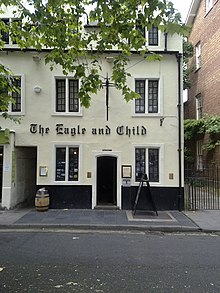
The Eagle and Child pub off St. Giles Street, Oxford - Christ Church College: The college archive at Christ church has a baptismal register on which Dorothy L. Sayers’ name appears [6]. And, a fairly tenuous link, however one of the characters from Sayers’ Gaudy Night, Lord Saint-George, was depicted as being a student at Christ Church.
- The Eagle and Child: The Eagle and Child is a pub in Oxford where members of the literary group, the Inklings (which included J.R.R. Tolkien, Charles Williams, C.S. Lewis, Owen Barfield and others), met on occasion in the 1930s and 40s to read aloud and receive feedback on their work. Although not a part of this group, Dorothy L. Sayers was friends with some of its members, including both C.S. Lewis and Charles Williams. Sayers attended the Socratic Club at Oxford while Lewis was president, and she read papers to this group. C.S. Lewis and Dorothy L. Sayers corresponded on occasion, and some of these letters can be found in Letters of C.S. Lewis and S. Lewis: A Biography. Having both known Charles William, Sayers and Lewis wrote a letter together to commemorate the 10th anniversary of William’s death [5]. The Eagle and Child, also known as ‘Bird and Baby’ can be found near Pusey Street in Oxford. Unfortunately, the pub shut during the COVID-19 pandemic.
References:
- https://www.sayers.org.uk/biography
- https://somethingrhymed.com/2015/04/01/agatha-christie-and-dorothy-l-sayers/
- https://www.chch.ox.ac.uk/blog/dorothy-l-sayers
- https://www.some.ox.ac.uk/eminent/dorothy-l-sayers/
- https://dc.swosu.edu/cgi/viewcontent.cgi?article=1478&context=mythlore
- Dorothy L Sayers | Christ Church, Oxford University
Val McDermid

Biography
Val McDermid, born June 4th 1955 in Scotland, Fife, is a well-known crime novelist [2]. Another St Hilda’s College alumnus, Val McDermid studied English there and was one of the youngest and first student’s from a Scottish State School to be admitted [2]. Following her graduation, Val McDermid became a journalist, training in Devon and then moving to Glasgow and Manchester to work for national newspapers there (returning to Oxford only to captain and win the Christmas University Challenge in 2016) [2]. When in Manchester, she was reportedly one of only three women at a firm with a total of 137 journalists [7]. In a recent talk at the Sheldonian (that I was lucky enough to attend) Val McDermid spoke about the blatant misogyny women experienced in the workplace, highlighting how women were often tasked with reporting topics to do with ‘women’s issues’, and that it was only in the late 1970s that women were allowed to do night shifts and wear trousers like their male colleagues. It was during this time, working as a journalist, that Val McDermid published her first successful novel in 1987, Report for Murder [2].
Val McDermid has subsequently won various accolades for her contribution to crime writing, including the CWA Diamond Dagger and the LGBTQ Saints and Sinners Hall of Fame. She was also awarded an honorary doctorate in 2011 by the University of Sunderland, and elected as a Fellow to both the Royal Society of Edinburgh, the Royal Society of Literature, and became a member of the much acclaimed Detection Club in 2000 [1].
For those who enjoy literary festivals (in particular, ones that solely revolve around crime writing!), Val McDermid also co-founded the Harrogate Crime Writing Festival [5], which this year takes place between the 20th and 23rd of July. During Val McDermid’s talk at the Sheldonian, I was also surprised to learn that Val McDermid is part of the Fun Lovin’ Crime Writers band who played at Glastonbury a few years ago. In fact, Val McDermid is the lead singer of the group, and their band will be playing at the Agatha Christie Festival this year!
Literary Career
detective novels typical of the 1920s and 30s, like Agatha Christie’s ‘Body in the Library’. Indeed, Val McDermid has described her writing to fall within the ‘Tartan Noir’ genre [8], a genre particular to Scottish crime writers [9] characterised by darker and grittier storylines, and an exploration of Scotland’s people and landscapes [10].
My first introduction to Val McDermid novels was the Tony Hill and Carol Jordan series, which follows a forensic psychologist and detective working together to solve what tend to be increasingly grim cases. However, Val McDermid has written many other standalone books, as well as four more ongoing series following characters such as detective Karen Pirie, journalist Lindsay Gorden, Kate Brannigan and Allie Burns [2]. She has sold over 16 million novels, and these have been translated into over 40 languages [3]. Her Karen Pirie and Carol Jordan and Tony Hill books have both been adapted for television [4].

In addition to her crime fiction, Val McDermid has written a children’s book as well as a few non-fiction novels – some to do with forensic science but others to do with Scotland – its landscapes and how she used them as inspiration for some of her novels [2]. As well as books, Val McDermid has also written plays, TV series, drama series and documentaries over the radio [2].
Links to Oxford
Like other crime writers Mavis Doriel Hay and P.D. James, except over 40 years later, Val McDermid attended St Hilda’s College to read English, which she thoroughly enjoyed [6].
Attending Val McDermid’s talk at the Sheldonian as a library trainee, it was also nice to learn that Val McDermid loved using the libraries in Oxford, with the Radcliffe Camera being one of her favourite study spaces [6]. McDermid has even used the building in a “very final, dramatic scene” in a book, in which the characters have an “unconventional use for the Radcliffe” – hopefully this “unconventional use” of the library does not include the characters bringing in any food or drink!
References:
- Val McDermid – Wikipedia
- Welcome to the official website of the celebrated and best selling Scottish crime writer Val McDermid…
- Val McDermid: ‘To survive, you had to be twice as good as the guys’ | Val McDermid | The Guardian
- Val McDermid – Literature (britishcouncil.org)
- Val McDermid – Royal Society of Literature (rsliterature.org)
- VAL MCDERMID (ST HILDA’S, 1972) | Oxford Alumni
- Val McDermid: a life in writing | Books | The Guardian
- Val McDermid on the Remarkable Rise of Tartan Noir ‹ CrimeReads
- BBC – Tartan Noir: A very strange beast
- Wanner2014.pdf (ed.ac.uk)
Agatha Christie
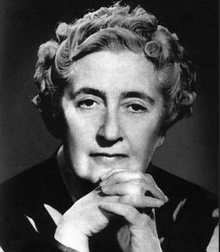
Biography
Of course, the list about Golden-Age crime writers would not be complete without celebrating the great Agatha Christie. Born in Torquay in 1890 to Frederick Alvah Miller and Clarissa Margaret Boehmer, Agatha Christie was, and still is, the best-selling detective novelist of all time [1, 2] (and after reading texts like The Murder of Roger Ackroyd or The ABC Murders, it is not surprising as to why!).

Billions of copies of her books have been sold worldwide, in a range of different languages [1]. And, her play ‘The Mousetrap’, which opened in 1952 in London’s West End, is the world’s longest-running play [1].
Like Gladys Mitchell, Val McDermid and Dorothy L. Sayers, Agatha Christie was a member of the Detection Club. In fact, alongside other successful detective novelists, such as Anthony Berkeley, Dorothy L. Sayers and Freeman Wills Crofts, Christie was one of the founding members of this society [9]. She even became president of the club but only after she had received absolute confirmation that someone else would be in charge of delivering public speeches as she was quite shy.
After a long and very successful career, Agatha Christie died on the 12th of January 1976 at age 85.
Literary Career

Although her mother did not want her daughter to read until aged eight, Agatha Christie taught herself to read by age five and began writing poems when she was still only a child [1] (her first piece of writing was a poem called The Cow Slip) [10]. She received no formal education until she was sent to finishing school in Paris in 1906, where she became an accomplished pianist [1, 6]. By this time, at 18 years old, Christie enjoyed writing short stories and novels which remained unpublished (including Snow Upon the Desert and The House of Beauty), and received feedback from family members, friends, as well as the author Eden Phillpotts who lived close to Ashfield, Agatha Christie’s family home (Peril at End House is dedicated to Phillpotts).
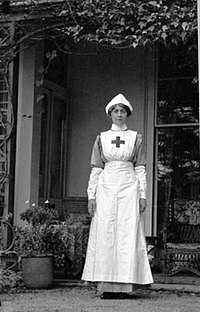
It was not until the 1910s, during the First World War working in a Red Cross hospital in Torquay, that Agatha Christie turned to writing detective stories after, rather fortunately for all Agatha Christie fans, being dared to do so by her older sister, Madge [11]. Using her knowledge of poisons, which she had gained while working as a member of the Voluntary Aid Detachment as a nurse and as a dispenser (for which she passed several exams to qualify as an apothecary’s assistant), Agatha Christie wrote her debut novel ‘The Mysterious Affair at Styles’ which was published in 1919 [5] and featured the now world-renowned Belgian moustached-detective: Hercule Poirot [1]. Initially, the denouement happened in a courtroom, and it was Christie’s publisher John Lane who insisted that the final chapter be reworked. This culminated in the much-loved final chapters in which Poirot, or another detective, gathers all the suspects in one room and dramatically reveals the true murderer (or murderers), an ending typical of many of Christie’s novels.
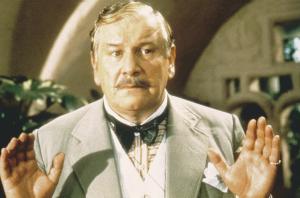
Incidentally, John Lane was one of the founders of The Bodley Head, a publishing house founded in 1887 which, perhaps unsurprisingly, took its name from a bust of Sir Thomas Bodley (founder of the Bodleian Library) which sat above the shop door [14].
While at the hospital, Agatha Christie also wrote, alongside friends with whom she worked, articles for their handmade and light-hearted hospital magazine kept at the Christie Archive Trust in Wales. The group called themselves ‘The Queer Women’. For those interested, BBC iPlayer currently has a series of brilliant documentaries about Agatha Christie, in which Lucy Worsley flicks through pages from the magazine (about 30 minutes into the first episode) [12].
Following the war, Agatha Christie and her husband and daughter, Archie Christie and Rosalind Christie, moved to Sunningdale and named their house ‘Styles’ [3]. Agatha Christie continued to write and publish novels including ‘The Murder of Roger Ackroyd’, ‘Murder on the Links’ and ‘The Man in the Brown Suit’, among others [14].
Towards the later stages of her career, Agatha Christie re-married and travelled extensively with her archaeologist husband, Max Mallowan, to watch and support archaeological digs. One such excavation site that she visited was Howard Carter’s in the Valley of the King’s in 1922, while Carter and his team were working on the excavation of Tutankhamun’s tomb [16]. Agatha Christie’s interest in archaeology and the Middle-East is evident when reading her books, including ‘Murder on the Orient Express’, ‘Murder in Mesopotamia’, ‘Death on the Nile’ and many more.

Although mainly known for her detective novels, Agatha Christie wrote different types of novels under pseudonyms including: Mary Westmacott (a combination of her second name and the surname of distant family relatives) and Agatha Mallowan (using her married name) [17]. Completely anonymous as Mary Westmacott, Agatha Christie had the freedom to write novels of a different genre to her expected detective fiction [18]. Christie wrote 6 novels as Mary Westmacott: Giant’s Bread (1930), Unfinished Portrait (1934) Absent in the Spring (1944), The Rose and the Yew Tree (1947), A Daughter’s a Daughter (1952) and The Burner (1956), and these were often described as ‘romantic novels’ at the time. Nevertheless, Agatha Christie’s daughter and grandson label these more as biographical novels, dealing with human psychology, relationships and love [18, 19]. Unfortunately, in 1946 it was discovered by readers that Agatha Christie and Mary Westmacott were one and the same [1], and Christie no longer had the opportunity to indulge in the freedom of writing anonymously as Westmacott.
Following Agatha Christie’s second marriage to Max Mallowan, Christie occasionally wrote under her married name, Agatha Mallowan. Most of what she published as Agatha Mallowan had to do with archaeology and the archaeological digs she visited while accompanying her husband.
Links to Oxford
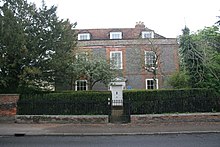

Agatha Christie lived in Winterbrook House in Wallingford, Oxfordshire, with her second husband, archaeologist and All Souls fellow Max Mallowan, for 42 years [21]. He and Agatha Christie met in 1928 at an archaeological site she visited at Ur. Two years later, she and Mallowan were married in Edinburgh at St Cuthbert’s Church – Agatha Christie had a few reservations about the age gap between them (she was 39 years old and her husband was 26), and so their marriage certificate states that Christie was 37 and Mallowan was 31.
For those who are Agatha Christie fans, I would highly recommend the Agatha Christie-themed walking tour in Wallingford, Oxfordshire. Below are a few places you can visit on this self-directed tour (as listed on the helpful Agatha Christie trail guide):
- Wallingford Museum: The Wallingford Museum has a small Agatha Christie exhibition, with photographs of Christie, handwritten letters, and quotes from those who met Agatha Christie while she lived in Wallingford. You can pick up a leaflet for the Agatha Christie trail guide, and (for Midsomer Murders fans) you can collect a leaflet for the Midsomer Murders trail in Wallingford.
-
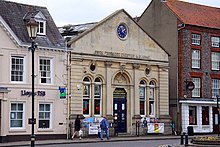
Corn Market Market Place: In the Market Place you will be able to see the Corn Exchange which was built in 1856 and now hosts the Sinodum Players. This drama group was of interest to Agatha Christie, and in 1951 she became their President. This was only under the condition that she did not need to attend official functions. When she attended the plays, the same two seats were reserved for Agatha Christie and her husband Max Mallowan, and a complimentary box of chocolates was also offered to her. She asked for her attendance not to be announced [23].
- Winterbrook House: This is where Agatha Christie lived with her husband Max Mallowan for 42 years. It is privately owned now, but it is possible to glimpse the blue plaque stuck beside the front door to the house.
- St Mary’s Church: After a half-hour (ish) walk through the country, you’ll find St Mary’s Church where Agatha Christie is buried. Her gravestone has a quote from the Faerie Queene by Edmund Spenser. Agatha Christie is buried with her husband. Unfortunately, his title as ‘Archaeologist’ was misspelt on the gravestone!
St Mary’s Church, Cholsey 
Agatha Christie’s gravestone - Mary Mead: About 10 minutes walk from St Mary’s Church, you’ll find a small road sign spelling out ‘St Mary Mead’ where, for those in the know, a certain literary character of the name Jane Marple resides.
Fun Facts
- Agatha Christie was the first British woman to surf standing up.
- Agatha Christie wrote N or M? during World War II, a wartime novel featuring a certain ‘Major Bletchley’. Christie’s choice of ‘Major Bletchley’ as a name for her character in the novel, led to a small investigation by MI5 to ensure that Christie had not guessed what truly was going on at Bletchley Park. She later revealed that she named her unlikeable character ‘Bletchley’ as a revenge for when her train from Oxford to London got stuck at Bletchley for a considerable length of time [22].
References:
- About Agatha Christie – The world’s best-selling novelist – Agatha Christie
- Agatha Christie – Wikipedia
- ‘I just wanted my life to end’: the mystery of Agatha Christie’s disappearance | Biography books | The Guardian
- When the World’s Most Famous Mystery Writer Vanished – The New York Times (nytimes.com)
- How Agatha Christie’s wartime nursing role gave her a lifelong taste for poison | UK news | The Guardian
- How Agatha Christie’s Terrible Experience As WWI Nurse Helped Inspire Hercule Poirot (warhistoryonline.com)
- How Agatha Christie Became an Expert on Poison | Time
- https://solo.bodleian.ox.ac.uk/permalink/f/1lj314/TN_cdi_proquest_reports_2722240220
- The Detection Club – Martin Edwards Books
- http://wdhg.org.uk/presentations/Agatha%20Christie%20in%20Devon.pdf
- https://www.agathachristie.com/en/about-christie#christies-life
- https://www.ft.com/content/4ba2d16d-2dce-49d8-bae6-625f18c3a0f1
- https://www.agathachristie.com/en/news/2016/book-of-the-month-the-mysterious-affair-at-styles
- https://collections.reading.ac.uk/special-collections/collections/the-bodley-head-ltd-publisher/
- https://www.agathachristie.com/en/about-christie
- The Rise and Fall of Ancient Egypt by Toby Wilkinson; Myths and Legends of Ancient Egypt by Joyce Tyldesley; and Egyptian Dawn by Robert Temple | History books | The Guardian
- access_points_and_headings.pdf (cambridge.org)
- Mary Westmacott, the real Agatha Christie – Peter Harrington Journal – The Journal
- Curtain: Poirot’s Last Case by Agatha Christie – Agatha Christie
- How Agatha Christie’s Terrible Experience As WWI Nurse Helped Inspire Hercule Poirot (warhistoryonline.com)
- Max Mallowan | All Souls College (ox.ac.uk)
- Agatha Christie was investigated by MI5 over Bletchley Park mystery | Agatha Christie | The Guardian
- http://www.wallingfordmuseum.org.uk/
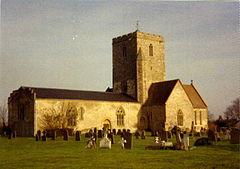

Recent Comments